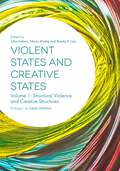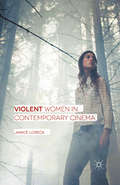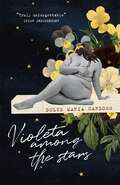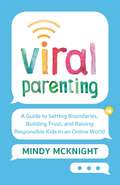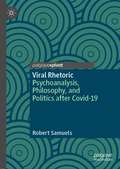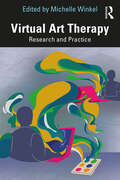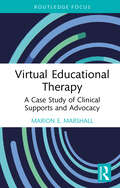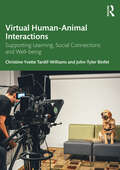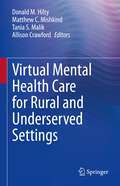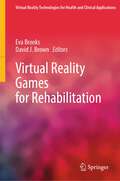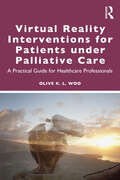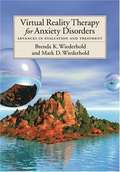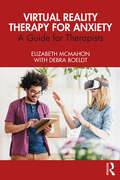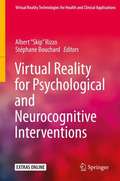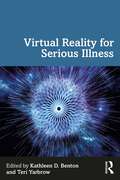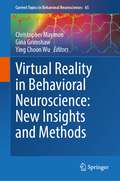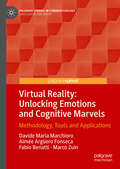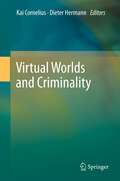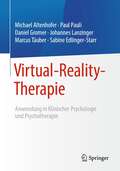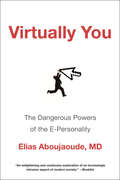- Table View
- List View
Violent States and Creative States: Structural Violence and Creative Structures (Volume #1)
by John Adlam Tilman Kluttig Bandy LeeThis is a provocative collection exploring the different types of violence and how they relate to one another, examined through the integration of several disciplines, including forensic psychotherapy, psychiatry, sociology, psychosocial studies and political science. By examining the 'violent states' of mind behind specific forms of violence and the social and societal contexts in which an individual act of human violence takes place, the contributors reveal the dynamic forces and reasoning behind specific forms of violence including structural violence, and conceptualise the societal structures themselves as 'violent states'. Other research often stops short at examining the causes and risk factors for violence, without considering the opposite states that may not only mitigate, but allow for a different unfolding of individual and societal evolution. As a potential antidote to violence, the authors prescribe an understanding of these 'creative states' with their psychological origins, and their importance in human behaviour and meaning-seeking. Making a call to move beyond merely mitigating violence to the opposite direction of fostering creative potential, this book is foundational in its capacity to cultivate social consciousness and effect positive change in areas of governance, policy-making, and collective responsibility. Volume 1: Structural Violence and Creative Structures covers structural and symbolic violence, with violent states and State violence, and with creative responses and creative states at the local and global levels.
Violent Women in Contemporary Cinema
by Janice LoreckViolent women in cinema pose an exciting challenge to spectators, overturning ideas of 'typical' feminine subjectivity. This book explores the representation of homicidal women in contemporary art and independent cinema. Examining narrative, style and spectatorship, Loreck investigates the power of art cinema to depict transgressive femininity.
Violeta among the Stars
by Dulce Maria CardososuddenlyI should have stayed at home, I should have stayed at home, I should have stayed at home, for some time, seconds, hours, I can do nothing,suddenly I stopVioleta is driving along a lonely stretch of late-night motorway, in the midst of a fearsome storm. When her tired eyes close for just a second, her car veers off the road, rolls down a muddy embankment, over and over, and comes to rest on an empty stretch of sodden ground. And as she lies amid the wreckage of her car, suspended between this world and the next, Violeta's life will quite literally flash before her eyes . . .Scenes from her past overlap with what happened right before the accident: her upbringing with her distant, critical mother; her father's mysterious double-life; her troubled relationship with her daughter; her life on the road as she drives between waxing product-selling appointments with breaks at motorway service stations, the abuse from other travellers mocking her size, the alcohol, the risky encounters with lorry drivers on filthy public toilet floors...Violeta Among the Stars weaves memories and feelings as Violeta reflects on her death, her life, her reality and her dreams. An astonishing portrait of a seemingly insignificant life, from one of Portugal's greatest living writers.Translated from the Portuguese by Ángel Gurría-Quintana
Violeta among the Stars
by Dulce Maria CardososuddenlyI should have stayed at home, I should have stayed at home, I should have stayed at home, for some time, seconds, hours, I can do nothing,suddenly I stopVioleta is driving along a lonely stretch of late-night motorway, in the midst of a fearsome storm. When her tired eyes close for just a second, her car veers off the road, rolls down a muddy embankment, over and over, and comes to rest on an empty stretch of sodden ground. And as she lies amid the wreckage of her car, suspended between this world and the next, Violeta's life will quite literally flash before her eyes . . .Scenes from her past overlap with what happened right before the accident: her upbringing with her distant, critical mother; her father's mysterious double-life; her troubled relationship with her daughter; her life on the road as she drives between waxing product-selling appointments with breaks at motorway service stations, the abuse from other travellers mocking her size, the alcohol, the risky encounters with lorry drivers on filthy public toilet floors...Violeta Among the Stars weaves memories and feelings as Violeta reflects on her death, her life, her reality and her dreams. An astonishing portrait of a seemingly insignificant life, from one of Portugal's greatest living writers.Translated from the Portuguese by Ángel Gurría-QuintanaÁngel Gurría-Quintana is a historian, journalist and literary translator from Spanish and Portuguese. He writes regularly for the books pages of the Financial Times, and his translations include the anthology Other Carnivals: Short Stories from Brazil and The Return, by Dulce Maria Cardoso.With the support of the Creative Europe Programme of the European Union
Viral Parenting: A Guide to Setting Boundaries, Building Trust, and Raising Responsible Kids in an Online World
by Mindy McKnightMindy McKnight, YouTube's favorite mom, shares the tools parents need to keep kids safe in their online lives--and shows how to create stronger family relationships as they do. A cross between Jen Hatmaker and Rosalind Wiseman, VIRAL PARENTING is a guide to raising responsible, safe, and communicative kids in the digital world. Mindy shares practical tools for having honest conversations with kids of all ages about privacy, bullying, respectfulness, and family time, while emphasizing the importance of trust and open communication. These strategies are timeless--whether applied to texting, snapping, Facebooking, kiking, or whatever social media platforms await us in the future, this book is ultimately about teaching children about personal responsibility and safety. Mindy shares practical tools for creating family rules for kids of all ages about privacy, bullying, respectfulness, and family time, while emphasizing the importance of trust and open communication. Using family contracts, guided conversations, device checks, and respectful but firm oversight, the McKnights have raised a close knit family and navigated the complexity of being world-wide internet celebrities with grace. McKnight will show any parent of any child or teen how that's done--setting non-negotiable guidelines and offering a savvy perspective toward privacy that audience have been begging for.
Viral Rhetoric: Psychoanalysis, Philosophy, and Politics after Covid-19
by Robert SamuelsThis book looks at the representation of viruses in rhetoric, politics, and popular culture. In utilizing Jean Baudrillard’s concept of virality, it examines what it means to use viruses as a metaphor. For instance, what is the effect of saying that a video has gone viral? Does this use of biology to explain culture mean that our societies are determined by biological forces? Moreover, does the rhetoric of viral culture display a fundamental insensitivity towards people who are actually suffering from viruses? A key defining aspect of this mode of persuasion is the notion that due to the open nature of our social and cerebral networks, we are prone to being infected by uncontrollable external forces. Drawing from the work of Freud, Lacan, Laclau, Baudrillard, and Zizek, it examines the representation of viruses in politics, psychology, media studies, and medical discourse. The book will help readers understand the potentially destructive nature of how viruses are represented in popular media and politics, how this can contribute to conspiracy theories around COVID-19 and how to combat such misinterpretations.
Virginia Satir: Foundational Ideas
by Barbara Jo Brothers“Amid these [world] changes is the growing conviction that human beings must evolve a new consciousness that places a high value on being human, that leads toward cooperation, that enables positive conflict resolution, and that recognizes our spiritual foundations. Can we accept as a given that the self of the therapist is an essential factor in the therapeutic process? If this turns out to be true, it will alter our way of teaching therapists as well as treating patients.” (Virginia Satir in The Use of Self in Therapy, The Haworth Press, Inc., 1987Virginia Satir, an internationally renowned educator and master therapist and a pioneer in the field of family therapy, altered the way therapists are taught and patients are treated. This landmark volume focuses on the important contributions that she made to the therapy profession. Written and edited by therapists who trained and worked closely with her, Virginia Satir: Foundational Ideas reflects her most basic ideas about the healing quality of respect for all people and the emphasis on the personal aspects of treatment rather than the technical. It also addresses the necessity of emotional honesty between the therapist and the patient and illustrates these therapists’impact on therapy as it is practiced today.The legacy left by Dr. Satir includes her profound insight into the behavior of human beings and the guidelines for the application of universal principles in such a way as to enhance human growth and unite individuals. Her impact on therapists around the world is apparent upon reading this triumphant volume. Scholars and practitioners address some of the fundamental tenets of therapy as developed by Dr. Satir and explain how they have integrated these basic foundations into their own practices. The highlights of her professional contributions that are discussed in this exhaustive volume include: the basic patterns of communication that are common to all people and the relationship of communication and self-esteem the triad concept and strategies for teaching people to exist in this basic unit of humankind in a healthy way the parts party and how this process for integrating various aspects of a person can be used with couples as well the model for change process and the ways in which it can be used with individuals, couples, and the world family reconstruction and the value of acting out the past with the therapist as guideVirginia Satir: Foundational Ideas is a sharp, clear focus on the person and work of this great master. It is necessary reading for all professionals around the world who seek to better understand the therapy process and the keys to its success.
Virginia Woolf and Neuropsychiatry
by Maxwell BennettThis book, written by one of the leaders in the field of the neurosciences, will give an explanation of the symptoms and eventual untimely suicide of one of literatures greatest authors; Virginia Woolf. The sources used are letters and statements from Woolf herself, the literature she wrote and comments, letters and any other documentation that referred to her mental state and her medical status. The author will use current insight into depression, the mental consequences of child abuse and drug interactions/effects to illustrate this case study. The book should appeal to researchers in the neurosciences, psychology and psychiatry as well as to a broader audience, mainly individuals who are interested in the (external and internal) forces that drove Woolf to write her material.
Virtual Art Therapy: Research and Practice
by Michelle WinkelThis book provides a practical and research-based exploration of virtual art psychotherapy, and how its innovations are breaking new ground in the mental health field. With seventeen chapters authored by leaders documenting their research on creative arts therapies online, along with findings from the Virtual Art Therapy Clinic, this volume presents examples, strategies, and experiences delivering arts-based therapeutic services and online education. Clinical practice examples support and provide evidence for the transition from in-person to virtual sessions. By combining the collected expertise of all the contributing authors, this book encourages art therapists to support further growth in the field of virtual art therapy.
Virtual Educational Therapy: A Case Study of Clinical Supports and Advocacy
by Marion E. MarshallVirtual Educational Therapy presents a board-certified educational therapist’s year-long case study of clinical supports and advocacy for a student with learning disabilities who is attending school remotely during the COVID-19 pandemic. With online and blended learning, now the norm in K–12 education, educational therapists need new models of intervention, treatment, and relationship-building for their child-age clients. This book offers detailed single-case research focused on a middle-school student who is learning virtually while challenged with ADHD as well as visual and verbal memory issues, but who is nonetheless found ineligible for special education services. Across eight chapters, author and renowned educational therapist Marion E. Marshall describes the neuropsychological principles, research-based techniques, personal interactions, clinical approaches, and advocacy efforts that led to a vulnerable student’s significant gains in academic skills and outcomes.
Virtual Human-Animal Interactions: Supporting Learning, Social Connections and Well-being
by John-Tyler Binfet Christine Yvette Tardif-WilliamsInterest in the field of human-animal interactions is burgeoning, and researchers and educators are keen to understand the science undergirding research that helps us understand interactions between people and animals. Recently, exciting and innovative research is focusing on how people’s virtual interactions with animals can enhance their learning, social interactions, and well-being. This research aims to answer questions such as, "What types of interactions do people have with animals in a virtual context? How do people access and experience their virtual interactions with animals? Do virtual interactions with animals hold potential to enhance people’s well-being and learning in the same way that in-person interactions with animals have been documented? What educational strategies could be employed to enhance people’s virtual interactions with animals? How can we respect animals as research participants within a virtual context?" Drawing from seminal and cutting-edge research in the field of human-animal interactions, these questions and others are answered in Virtual Human-Animal Interactions. Research-informed and grounded in critical discussions of theory and practice, this book challenges readers to reconceptualize their understanding of research and practice exploring the complexities inherent in, and arising from, people’s virtual interactions with animals. Further, with an eye to the future, this book illuminates readers’ thinking around the empirical and practical implications of facilitating interactions between people and animals within virtual contexts. Researchers and educators from across disciplines will find Virtual Human-Animal Interactions both scientifically savvy and practical.
Virtual Mental Health Care for Rural and Underserved Settings
by Allison Crawford Donald M. Hilty Matthew C. Mishkind Tania S. MalikThis book focuses on the critical area of delivering mental health services in rural settings. It is designed as a practical guide to the technological provision of timely, effective, evidence-based care, helpful to the novice and the experienced practitioner alike. The benefits of this approach are: Improved access to and improved quality of careTechnical support for providers and administratorsA means of providing missing specialty careAn ability to maximize scarce resources and significant flexibility for health service delivery. The book will cover how to adjust therapeutic skills to patients’ needs, models of care and the particular technology used. It shows how rudimentary design of workflow can assist in integrating care, and highlights the importance of allowing for cultural needs (both rural geography and ethnic/race). Administrative issues are also addressed (e.g., privacy, reimbursement). The chapters are short and designed for maximum practicality, including learning objectives, cases and summaries emphasizing “what to do and how to do it.”
Virtual Reality Games for Rehabilitation (Virtual Reality Technologies for Health and Clinical Applications)
by Eva Brooks David J. BrownThis volume focuses on games to manage and facilitate rehabilitation. It emphasizes user practice, attitudes, and experience, and their changing place within developing rehabilitation frameworks. It looks at how users have adopted, integrated, and innovated with games to facilitate rehabilitation. Topics include game technology, game design and accessibility, web-based technologies vs pervasive and mobile technologies, social and collaborative aspects, and rehabilitative outcome. Games for rehabilitation are gaining interest from different communities such as medicine, psychology, and rehabilitation. A distinction can be made between games specifically made for rehabilitative purposes and games made for the general public but that are used in rehabilitation as well. Games have allowed the building of new/complementary forms for rehabilitation and offered new options to produce rehabilitative activities and experiences.
Virtual Reality Interventions for Patients Under Palliative Care: A Practical Guide for Healthcare Professionals
by Olive K. WooVirtual Reality Interventions for Patients under Palliative Care is a groundbreaking guide that empowers healthcare professionals to transform end-of-life care with the innovative use of virtual reality (VR).This book equips clinicians with the knowledge and skills they need to seamlessly integrate state-of-the-art VR technology into palliative care, addressing a wide range of patient needs, from pain management to wish fulfillment. The book’s special features include evidence-based VR interventions, practical implementation strategies, assessment tools, case studies, clinical tips, and suggested scripts for engagement, preparation, and assessment.Grounded in robust research, theory, and practical expertise, this guidebook is a must-read for any researcher or professional who wants to enhance the quality of life for terminally ill patients and their families through VR technology, which offers a novel and transformative approach that sets it apart from traditional palliative care practices.
Virtual Reality Therapy For Anxiety Disorders: Advances In Evaluation And Treatment
by B. K. Wiederhold Mark D. Wiederhold<P>"The main goal of this book is to provide information on the applicability of virtual reality (VR) to the treatment of anxiety disorders.<P> We explain what VR is, what type of technology it involves, and how it is applied in clinical practice. <P>We also describe practical, hands-on strategies and interventions designed to guide therapists through each step of the treatment process for each of the specific anxiety disorders.<P> The book begins with an overview of VR and its clinical applications for treating anxiety disorders. The remainder of the book is divided into three parts. <P>Part I, which includes chapters 1 and 2, explains VR as a technology.<P> Part II (chaps. 3-7) is intended as a user's guide to help clinicians understand how VR is implemented in the treatment of anxiety disorders.<P> Part III (chaps. 8-17) is devoted to the treatment of specific anxiety disorders. <P>After a brief introduction, the chapters are arranged from the more generalized disorders to the more specific phobias.<P> Differences in the length of these chapters reflect the ease with which these disorders lend themselves to virtual reality graded exposure therapy and the amount of research and clinical work that has been completed in these areas.<P> The final chapter discusses the state of current research and future directions.<P> It provides comments about the outlook for therapeutic VR applications in the future. <P>An appendix provides a resource list as well as a listing of the various measurement tools used in the assessment of both general anxiety and the specific phobias"--Introd. <P>(PsycINFO Database Record (c) 2005 APA, all rights reserved).
Virtual Reality Therapy for Anxiety: A Guide for Therapists
by Elizabeth McMahon Debra BoeldtPractical, down to earth, clearly written, and easy for therapists to understand and apply, Virtual Reality Therapy for Anxiety is a useful guide for any clinician treating anxiety, regardless of setting (in-office or via telehealth), theoretical orientation, or level of training. Written by an experienced psychologist who has used multiple VR systems since 2010, it’s the only up to date, clinically informed, evidence-based training manual available. Easy-to-understand concepts and diagrams explain anxiety and its treatment, and the book incorporates research findings and clinical expertise. VRT is described step by step with multiple case examples, and an extended case-vignette chapter presents a session-by-session treatment protocol of a complex case with transcript excerpts. Key findings and quotations from research are also presented. After completing the guide, therapists and other mental health professionals will understand the unique clinical benefits of VR, be prepared to use VR in therapy comfortably and effectively either in the office or remotely, and will have expertise in a new, needed, and empirically validated treatment for a common clinical problem.
Virtual Reality for Psychological and Neurocognitive Interventions (Virtual Reality Technologies for Health and Clinical Applications)
by Stéphane Bouchard Albert “Skip” RizzoThis exciting collection tours virtual reality in both its current therapeutic forms and its potential to transform a wide range of medical and mental health-related fields. Extensive findings track the contributions of VR devices, systems, and methods to accurate assessment, evidence-based and client-centered treatment methods, and—as described in a stimulating discussion of virtual patient technologies—innovative clinical training. Immersive digital technologies are shown enhancing opportunities for patients to react to situations, therapists to process patients’ physiological responses, and scientists to have greater control over test conditions and access to results. Expert coverage details leading-edge applications of VR across a broad spectrum of psychological and neurocognitive conditions, including: Treating anxiety disorders and PTSD.Treating developmental and learning disorders, including Autism Spectrum Disorder,Assessment of and rehabilitation from stroke and traumatic brain injuries.Assessment and treatment of substance abuse.Assessment of deviant sexual interests.Treating obsessive-compulsive and related disorders.Augmenting learning skills for blind persons. Readable and relevant, Virtual Reality for Psychological and Neurocognitive Interventions is an essential idea book for neuropsychologists, rehabilitation specialists (including physical, speech, vocational, and occupational therapists), and neurologists. Researchers across the behavioral and social sciences will find it a roadmap toward new and emerging areas of study.
Virtual Reality for Serious Illness
by Kathleen D. Benton Teri YarbrowVirtual Reality for Serious Illness explores the important role virtual-reality interventions can play in symptom management, anxiety control, and spiritual meaning. This book focuses on cutting-edge research and its effects on the seriously ill and those who treat the seriously ill. The innovation in this book is twofold: It is a global look at the use of virtual reality in complex medical cases where it takes an interdisciplinary look at use of virtual reality, and it includes a strong focus on the spiritual healing resulting from the meaning and purpose found during this intervention.The book is written for professionals who use holistic healing measures in the scope of treatment for chronic and seriously ill patients. It is written for all disciplines acting in holistic healthcare healing, including physicians, chaplains, nurses, and informatics interventionists.
Virtual Reality in Behavioral Neuroscience: New Insights and Methods (Current Topics in Behavioral Neurosciences #65)
by Christopher Maymon Gina Grimshaw Ying Choon WuVirtual Reality (VR) is a rapidly maturing technology that offers new and unique solutions to otherwise intractable problems in the study of cognition, behavior and neuroscience. VR removes many of the constraints imposed by laboratory paradigms, allowing us to track cognitive, behavioral and brain responses to naturalistic (or even impossible) situations without sacrificing experimental control. But VR is not a tool that can be swiftly and effortlessly integrated into existing research pipelines; currently, the benefits of VR are accompanied by a host of methodological challenges and important practical considerations. To help navigate this new methodology, this volume provides a balanced review of both the exciting new findings emerging from VR labs and the challenges and limitations that are part and parcel of VR research. This volume is an important first step toward establishing a standardised methodology for conducting research in VR. To this end, the volume provides a wealth of practical advice for researchers who are new to the technology. This volume is authored by an interdisciplinary team of VR researchers including computer scientists, engineers, psychologists and neuroscientists. It highlights current research in the field to demonstrate how VR advances our understanding of the mind, while also providing groundbreaking solutions in applied domains.
Virtual Reality: Methodology, Tools and Applications (Palgrave Studies in Cyberpsychology)
by Fabio Benatti Davide Maria Marchioro Aimée Argüero Fonseca Marco ZuinThis book is an invaluable resource for researchers, practitioners, and enthusiasts interested in unraveling the potential and promises of virtual reality, delving into its applications, challenges, and the exciting path that lies ahead. In the age of rapidly advancing technology, the intersection of psychology and virtual reality (VR) has opened doors to a world of unprecedented possibilities. This introduction sets the stage for an exploration of the potential of virtual reality within the field of psychology and its intriguing relationship with cyberpsychology. In this book, the authors aim to utilize the transformative power of VR to enhance our understanding of the human mind and emotions, ultimately contributing to the betterment of psychological science and the human experience. The ability to simulate environments, elicit emotional responses, and assess cognitive functions in a controlled, replicable manner presents a paradigm shift in psychological research and practice.
Virtual Worlds and Criminality
by Dieter Hermann Kai Cornelius, LL.M.The fusion between virtuality and reality has created a new quality of experience establishing metaverses and virtual worlds. Second Life, Twinity, Entropia Universe or Fregger have experienced rapid growth in recent years and show no signs of slowing down. Not only have countless companies discovered these "virtureal worlds" as marketplaces, but so have fraudsters and other criminals. In this book, European experts from different academic disciplines show how to meet the new challenges arising from virtual worlds. They discuss the reasons for and the impacts of these new forms of criminality as well as the necessity and means of combating them. Moreover, other fundamental issues are examined, such as the addictive potential of virtual-world use, media violence, and conflict resolution problems arising in the context of virtual worlds.
Virtual-Reality-Therapie: Anwendung in Klinischer Psychologie und Psychotherapie
by Michael Altenhofer Paul Pauli Daniel Gromer Johannes Lanzinger Marcus Täuber Sabine Edlinger-StarrDie Expositionstherapie ist die effektivste Methode zur Behandlung von Angststörungen, insbesondere spezifischer Phobien. Doch was tun, wenn die Vorstellungskraft nicht reicht und für Konfrontationen mit angstauslösenden Situationen der Aufwand zu groß ist? Mit Virtual Reality eröffnen sich völlig neue Chancen. Computer-generierte realitätsnahe Spinnen, Höhen, Flugreisen oder soziale Kontakte erlauben, die Therapie unkompliziert unter kontrollierten Bedingungen und mit graduellen Steigerungen der Reizintensität durchzuführen. In diesem Fachbuch werden theoretische Grundlagen, wissenschaftliche Studien und erprobte Strategien für den Einsatz von VR in der Behandlung von Ängsten und Phobien kompakt, fundiert und praxisnah beschrieben. Sie erhalten wertvolle Tipps, wie auch Sie diese Technologie für Ihre therapeutische Arbeit nutzen.
Virtually You: The Dangerous Powers of the E-Personality
by Elias Aboujaoude"Instantly engaging and eminently accessible . . . . an enlightening and cautionary exploration of an increasingly intrusive aspect of modern society." --Booklist While the Internet can enhance well-being, Elias Aboujaoude has spent years treating patients whose lives have been profoundly disturbed by it. Part of the danger lies in how the Internet allows us to act with exaggerated confidence, sexiness, and charisma. Aboujaoude dubs this new self our "e-personality" and argues that its traits are too potent to be confined online. Offline, too, we're becoming impatient, unfocused, and urge-driven. Virtually You draws from Aboujaoude's personal and professional experience to highlight this new phenomenon. The first scrutiny of the virtual world's transformative power on our psychology, Virtually You demonstrates how real life is being reconfigured in the image of a chat room, and how our identity increasingly resembles that of our avatar.
Virtue Epistemology Naturalized: Bridges Between Virtue Epistemology and Philosophy of Science (Synthese Library #366)
by Abrol FairweatherThis book presents four bridges connecting work in virtue epistemology and work in philosophy of science (broadly construed) that may serve as catalysts for the further development of naturalized virtue epistemology. These bridges are: empirically informed theories of epistemic virtue; virtue theoretic solutions to under determination; epistemic virtues in the history of science; and the value of understanding.Virtue epistemology has opened many new areas of inquiry in contemporary epistemology including: epistemic agency, the role of motivations and emotions in epistemology, the nature of abilities, skills and competences, wisdom and curiosity.Value driven epistemic inquiry has become quite complex and there is a need for a responsible and rigorous process of constructing naturalized theories of epistemic virtue. This volume makes the involvement of the sciences more explicit and looks at the empirical aspect of virtue epistemology.Concerns about virtue epistemology are considered in the essays contained here, including the question: can any virtue epistemology meet both the normativity constraint and the empirical constraint? The volume suggests that these worries should not be seen as impediments but rather as useful constraints and desiderata to guide the construction of naturalized theories of epistemic virtue.
Virtuelle Führung in der Praxis: Ansätze und Herausforderungen in Remote-Unternehmen
by Anett StellerDie Digitalisierung der Arbeitswelt hat zu Veränderungen in der Struktur von Unternehmen und deren Arbeitsweisen geführt. Anett Steller untersucht die Herausforderungen und Praktiken der Führung in remote arbeitenden Unternehmen. Im Mittelpunkt der Analyse stehen die Führungsstile und -praktiken, die in virtuellen Teams als effektiv wahrgenommen werden, sowie die Faktoren, die für eine erfolgreiche Zusammenarbeit entscheidend sind. Durch eine Kombination aus Literaturreview und empirischer Feldforschung, bestehend aus Beobachtungen und Interviews mit Führungskräften und Mitarbeitenden, werden Einblicke in die realen Bedingungen und Prozesse der virtuellen Führung gewonnen. Die Ergebnisse zeigen, dass erfolgreiche virtuelle Führung eine Kombination aus transformationalen und dyadischen Ansätzen erfordert. Die Arbeit leistet einen Beitrag zur Forschung in der Berufs- und Wirtschaftspädagogik, indem sie aufzeigt, wie Führungskräfte die spezifischen Herausforderungen der digitalisierten Arbeitswelt durch angepasste Kommunikationsstrategien und Führungsmethoden meistern können, indem eine Konzeption zur virtuellen Führung skizziert wird.
